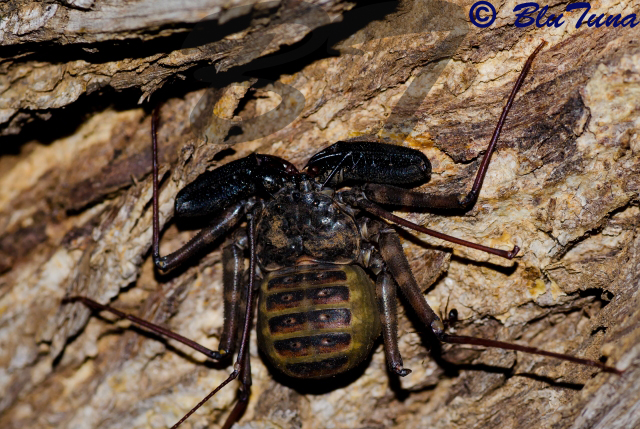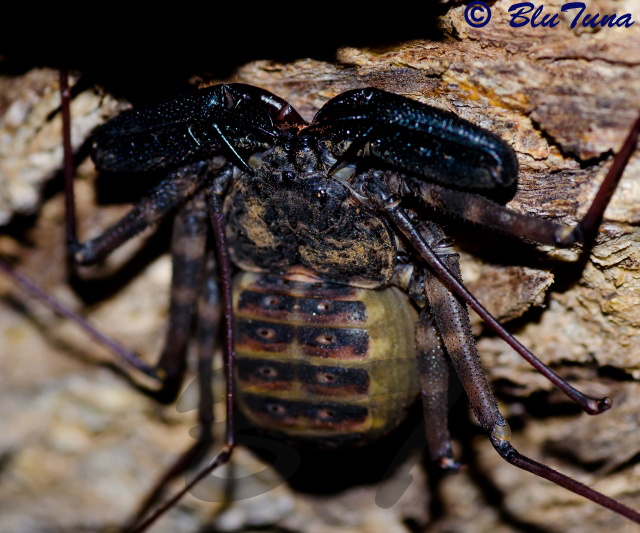AW Arachnid Book Whip Spiders Amblypygi Photos & Description
Posted: Sat Apr 05, 2014 11:23 am
Amblypygi is an order of invertebrate animals belonging to the class Arachnida. They form a separate order of arachnids alongside the spiders, scorpions and others.
Amblypygids are also known as whip spiders and tailless whip scorpions (not to be confused with whip scorpions that belong to the Arachnid order Thelyphonida). The name "amblypygid" means "blunt rump", a reference to a lack of the flagellum ("tail"). Whip spiders, also known as tailless whip scorpions, are a conspicuous group of bizarre, dorsoventrally flattened arachnids with raptorial pedipalps and a pair of extremely elongate, antenniform first legs. They are harmless to humans. Amblypygids possess no silk glands or venomous fangs. They rarely bite if threatened, but can grab fingers with pedipalps, resulting in thorn-like puncture injury.
They are found in tropical and subtropical regions worldwide. There are 17 genera and 136 species worldwide, with four genera and seven species native to southern Africa. Found mainly in the tropics and subtropics, occurring under rocks, in crevices and under bark.
Genera native to southern Africa:
All these genera are in the family Phrynichidae.
Damon: An African genus of 10 species, four of which are native to southern Africa.
Phrynichodamon: One species, Phrynichodamon scullyi, which is native to South Africa (Northern Cape) and Namibia.
Euphrynichus: Two species with one, Euphrynichus bacillifer, native to southern Africa. Its overall distribution includes Zimbabwe, Malawi, DRC, Angola, Tanzania, Kenya and Madagascar.
Xerophrynus: One species, Xerophrynus machadoi, which is native to Namibia and Angola.
Amblypygids range from 7.6 to 60 cm in size according to legspan. Their bodies are broad and highly flattened, with a solid carapace and a segmented abdomen. They have a pair of median eyes at the front of the carapace, located just above the chelicerae (in a manner somewhat similar to that of crustaceans), and possessed three smaller eye pairs placed further back on each side, for a total of eight eyes.
Amblypygids possess medium to poor eyesight. Their pedipalps, which serve as sensors for many related arachnids, are modified for grabbing and retaining prey, much like those of a mantis. The first pair of legs act as sensory organs and are not used for walking. The sensory legs are very thin and elongate, have numerous sensory receptors, and can extend several times the length of body. Typically, the animal holds one of these legs out in front of it as it moves, and uses the other to probe the terrain to the side.
Amblypygids often move about sideways on their six walking legs, with one "whip" pointed in the direction of travel while the other probes their other sides. Prey are located with these "whips", captured with pedipalps, then masticated with chelicerae.
Courting rituals involve the male depositing stalked spermatophores, which have one or more sperm masses at the tip, onto the ground, and using his pedipalps to guide the female over them. She gathers the sperm and lays fertilized eggs into a sac carried under the abdomen. When the young hatch, they climb up onto the mother's back; any which fall off before their first moult will not survive.
Amblypygids will consume any appropriately sized prey. Most of their diet likely consists of insects. Like many opportunistic predators, amblypygids can survive for two or three weeks without food. Before, during and after molting they generally do not feed. Like any other arachnid, an amblypygid will molt several times during its life.
Amblypygids are also known as whip spiders and tailless whip scorpions (not to be confused with whip scorpions that belong to the Arachnid order Thelyphonida). The name "amblypygid" means "blunt rump", a reference to a lack of the flagellum ("tail"). Whip spiders, also known as tailless whip scorpions, are a conspicuous group of bizarre, dorsoventrally flattened arachnids with raptorial pedipalps and a pair of extremely elongate, antenniform first legs. They are harmless to humans. Amblypygids possess no silk glands or venomous fangs. They rarely bite if threatened, but can grab fingers with pedipalps, resulting in thorn-like puncture injury.
They are found in tropical and subtropical regions worldwide. There are 17 genera and 136 species worldwide, with four genera and seven species native to southern Africa. Found mainly in the tropics and subtropics, occurring under rocks, in crevices and under bark.
Genera native to southern Africa:
All these genera are in the family Phrynichidae.
Damon: An African genus of 10 species, four of which are native to southern Africa.
Phrynichodamon: One species, Phrynichodamon scullyi, which is native to South Africa (Northern Cape) and Namibia.
Euphrynichus: Two species with one, Euphrynichus bacillifer, native to southern Africa. Its overall distribution includes Zimbabwe, Malawi, DRC, Angola, Tanzania, Kenya and Madagascar.
Xerophrynus: One species, Xerophrynus machadoi, which is native to Namibia and Angola.
Amblypygids range from 7.6 to 60 cm in size according to legspan. Their bodies are broad and highly flattened, with a solid carapace and a segmented abdomen. They have a pair of median eyes at the front of the carapace, located just above the chelicerae (in a manner somewhat similar to that of crustaceans), and possessed three smaller eye pairs placed further back on each side, for a total of eight eyes.
Amblypygids possess medium to poor eyesight. Their pedipalps, which serve as sensors for many related arachnids, are modified for grabbing and retaining prey, much like those of a mantis. The first pair of legs act as sensory organs and are not used for walking. The sensory legs are very thin and elongate, have numerous sensory receptors, and can extend several times the length of body. Typically, the animal holds one of these legs out in front of it as it moves, and uses the other to probe the terrain to the side.
Amblypygids often move about sideways on their six walking legs, with one "whip" pointed in the direction of travel while the other probes their other sides. Prey are located with these "whips", captured with pedipalps, then masticated with chelicerae.
Courting rituals involve the male depositing stalked spermatophores, which have one or more sperm masses at the tip, onto the ground, and using his pedipalps to guide the female over them. She gathers the sperm and lays fertilized eggs into a sac carried under the abdomen. When the young hatch, they climb up onto the mother's back; any which fall off before their first moult will not survive.
Amblypygids will consume any appropriately sized prey. Most of their diet likely consists of insects. Like many opportunistic predators, amblypygids can survive for two or three weeks without food. Before, during and after molting they generally do not feed. Like any other arachnid, an amblypygid will molt several times during its life.
 © Heksie
© Heksie © Pumbaa
© Pumbaa
 © BluTuna
© BluTuna © BluTuna
© BluTuna